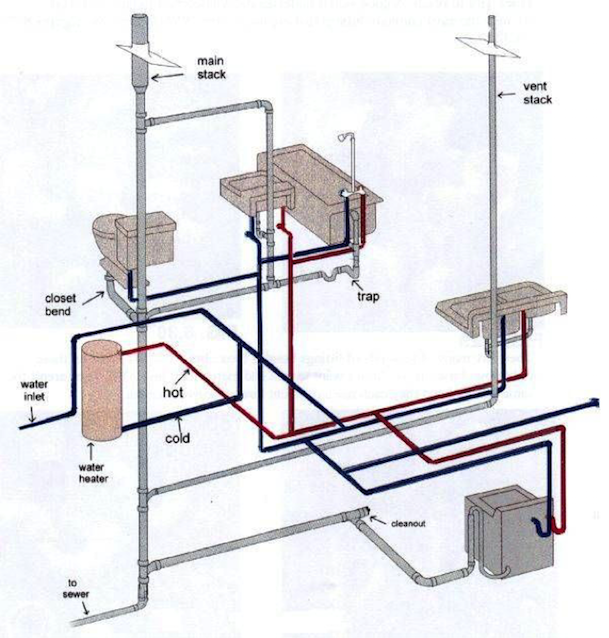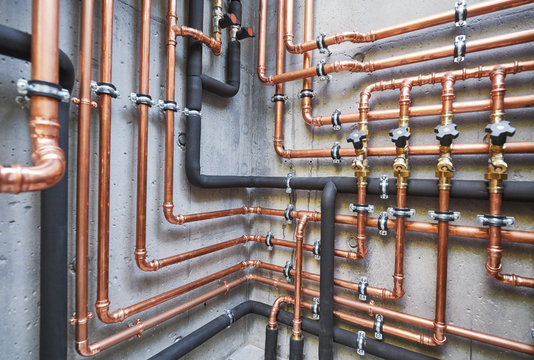The Fundamental Elements of Your House's Plumbing System
The Fundamental Elements of Your House's Plumbing System
Blog Article
Right here below you can get more awesome tips involving The Inner Workings of Your Home's Plumbing.

Understanding how your home's plumbing system works is important for every home owner. From supplying tidy water for drinking, cooking, and bathing to securely removing wastewater, a well-maintained pipes system is important for your family's wellness and comfort. In this comprehensive overview, we'll check out the elaborate network that makes up your home's plumbing and deal ideas on maintenance, upgrades, and dealing with usual problems.
Introduction
Your home's plumbing system is greater than simply a network of pipes; it's a complex system that guarantees you have accessibility to tidy water and reliable wastewater removal. Knowing its parts and how they work together can aid you stop costly repairs and guarantee every little thing runs efficiently.
Fundamental Components of a Pipes System
Pipelines and Tubes
At the heart of your plumbing system are the pipelines and tubing that carry water throughout your home. These can be constructed from various products such as copper, PVC, or PEX, each with its advantages in terms of toughness and cost-effectiveness.
Components: Sinks, Toilets, Showers, etc.
Components like sinks, commodes, showers, and bath tubs are where water is utilized in your home. Recognizing how these fixtures attach to the plumbing system aids in identifying issues and preparing upgrades.
Shutoffs and Shut-off Factors
Shutoffs regulate the flow of water in your plumbing system. Shut-off valves are important throughout emergency situations or when you need to make fixings, permitting you to separate parts of the system without disrupting water flow to the entire house.
Supply Of Water System
Key Water Line
The primary water line links your home to the community water or a private well. It's where water enters your home and is distributed to numerous components.
Water Meter and Stress Regulatory Authority
The water meter measures your water usage, while a pressure regulator ensures that water flows at a secure stress throughout your home's plumbing system, protecting against damages to pipes and components.
Cold Water vs. Warm water Lines
Understanding the difference in between cold water lines, which supply water directly from the primary, and warm water lines, which carry heated water from the hot water heater, helps in fixing and preparing for upgrades.
Drainage System
Drain Piping and Traps
Drain pipes bring wastewater far from sinks, showers, and commodes to the sewer or sewage-disposal tank. Catches protect against sewer gases from entering your home and likewise catch particles that could trigger obstructions.
Ventilation Pipes
Ventilation pipelines permit air into the drain system, stopping suction that can slow water drainage and cause traps to empty. Correct air flow is essential for preserving the stability of your plumbing system.
Significance of Proper Water Drainage
Making sure proper water drainage stops backups and water damage. Regularly cleaning up drains and keeping catches can avoid costly fixings and prolong the life of your plumbing system.
Water Furnace
Kinds Of Water Heaters
Hot water heater can be tankless or standard tank-style. Tankless heating units heat water as needed, while storage tanks save heated water for immediate usage.
Exactly How Water Heaters Link to the Plumbing System
Understanding just how hot water heater link to both the cold water supply and hot water circulation lines assists in identifying issues like insufficient warm water or leakages.
Maintenance Tips for Water Heaters
Regularly purging your hot water heater to eliminate sediment, examining the temperature level settings, and inspecting for leakages can extend its life-span and enhance energy efficiency.
Usual Plumbing Issues
Leakages and Their Causes
Leaks can take place because of aging pipelines, loose installations, or high water stress. Dealing with leaks immediately avoids water damages and mold and mildew growth.
Obstructions and Obstructions
Clogs in drains pipes and bathrooms are often brought on by flushing non-flushable things or an accumulation of grease and hair. Making use of drain displays and being mindful of what drops your drains can prevent blockages.
Signs of Pipes Problems to Expect
Low tide pressure, slow-moving drains, foul odors, or abnormally high water expenses are indicators of prospective pipes issues that need to be dealt with promptly.
Plumbing Upkeep Tips
Routine Examinations and Checks
Arrange yearly plumbing assessments to catch problems early. Look for indications of leakages, corrosion, or mineral build-up in faucets and showerheads.
Do It Yourself Upkeep Tasks
Easy jobs like cleaning tap aerators, looking for toilet leakages using dye tablet computers, or insulating subjected pipelines in cold environments can protect against major pipes concerns.
When to Call a Professional Plumbing Technician
Know when a plumbing problem calls for professional knowledge. Trying complex repair work without correct knowledge can result in even more damages and higher repair work expenses.
Updating Your Plumbing System
Reasons for Updating
Updating to water-efficient components or replacing old pipes can enhance water top quality, reduce water bills, and boost the worth of your home.
Modern Pipes Technologies and Their Benefits
Explore innovations like clever leakage detectors, water-saving toilets, and energy-efficient hot water heater that can conserve cash and reduce environmental effect.
Expense Factors To Consider and ROI
Compute the upfront costs versus long-lasting cost savings when taking into consideration pipes upgrades. Several upgrades pay for themselves through decreased utility expenses and less repair services.
Ecological Influence and Preservation
Water-Saving Fixtures and Appliances
Installing low-flow faucets, showerheads, and toilets can considerably decrease water usage without compromising performance.
Tips for Minimizing Water Usage
Easy practices like repairing leaks quickly, taking shorter showers, and running full loads of laundry and dishes can conserve water and lower your utility costs.
Eco-Friendly Plumbing Options
Think about lasting plumbing materials like bamboo for flooring, which is durable and environmentally friendly, or recycled glass for kitchen counters.
Emergency situation Readiness
Actions to Take Throughout a Plumbing Emergency
Know where your shut-off valves are located and exactly how to shut off the supply of water in case of a burst pipeline or significant leakage.
Value of Having Emergency Get In Touches With Handy
Keep call details for regional plumbing technicians or emergency solutions easily available for quick response throughout a pipes dilemma.
DIY Emergency Situation Fixes (When Relevant).
Momentary repairs like using air duct tape to spot a leaking pipe or positioning a container under a leaking faucet can decrease damages until a professional plumbing professional shows up.
Conclusion.
Understanding the makeup of your home's plumbing system empowers you to keep it efficiently, saving money and time on repair work. By following normal maintenance routines and remaining informed concerning contemporary plumbing modern technologies, you can ensure your plumbing system runs efficiently for several years to find.
HOW YOUR PLUMBING SYSTEM WORKS
Which Pipes Do What?
Blue lines = fresh water supply entering the building
Red lines = hot water supply entering the building
Grey lines = pipes carrying waste away from the building and venting pipes carrying gases away from the building (through the roof)
YOUR MAIN PLUMBING SYSTEMS
There are two main plumbing systems that support your home s basic plumbing needs one that brings clean water into your home, and one that sends dirty water away from your home. Connected to the toilet, bath, shower, and other faucets in your home, these two systems keep your water flowing in the right directions.
ACCESSING FRESH WATER
Fresh and clean water is brought into your home through the main water supply line . Filtered through one pipe, this water is pressured to flow into the various fixtures in your home at any given time.
This water can be sourced from a well located on your property, a pond or river (mostly cottages), or, as in most cases, from the city s municipal water treatment centre. However, it is important to note that water that is untreated, such as the water siphoned from ponds or rivers, may not be safe to drink. Personal water supplies always need to be treated for hardness and contaminants before consumed.
MUNICIPAL WATER SUPPLIES
Improve taste and odour
Remove sediment
Eliminate hardness
Reduce chlorine
COLD WATER SUPPLY VS. HOT WATER SUPPLY
Cold water flows into your home or building through the service line, which then distributes hot or cold water to your fixtures. This line is most commonly run through a central column that runs floor to floor. Hot water runs in short and straight pipes as the longer the pipeline, the more heat that will be lost in the transfer. Having shorter pipes also allows residents to access hot water more quickly.
WASTE WATER SYSTEM
Your wastewater system is divided into two parts pipes that send wastewater away from your home and venting pipes that send sewer gas away from your home. Sewage water travels through pipes that flush the water and waste towards local sewers that are operated and managed by your city or town. Most sewer systems rely on gravity to move the wastewater to where it needs to go.
The further away from your toilet or sink, the larger wastewater pipes become. This allows for waste to be disposed of from various parts of your home or business at once without pipe blockages. The angle and flow of these pipes are also essential for keeping your waste pipes clear of build up.
https://harrisplumbing.ca/how-your-home-plumbing-system-works/

HOW YOUR PLUMBING SYSTEM WORKS
Which Pipes Do What?
YOUR MAIN PLUMBING SYSTEMS
There are two main plumbing systems that support your home s basic plumbing needs one that brings clean water into your home, and one that sends dirty water away from your home. Connected to the toilet, bath, shower, and other faucets in your home, these two systems keep your water flowing in the right directions.
ACCESSING FRESH WATER
Fresh and clean water is brought into your home through the main water supply line . Filtered through one pipe, this water is pressured to flow into the various fixtures in your home at any given time.
This water can be sourced from a well located on your property, a pond or river (mostly cottages), or, as in most cases, from the city s municipal water treatment centre. However, it is important to note that water that is untreated, such as the water siphoned from ponds or rivers, may not be safe to drink. Personal water supplies always need to be treated for hardness and contaminants before consumed.
MUNICIPAL WATER SUPPLIES
COLD WATER SUPPLY VS. HOT WATER SUPPLY
Cold water flows into your home or building through the service line, which then distributes hot or cold water to your fixtures. This line is most commonly run through a central column that runs floor to floor. Hot water runs in short and straight pipes as the longer the pipeline, the more heat that will be lost in the transfer. Having shorter pipes also allows residents to access hot water more quickly.
WASTE WATER SYSTEM
Your wastewater system is divided into two parts pipes that send wastewater away from your home and venting pipes that send sewer gas away from your home. Sewage water travels through pipes that flush the water and waste towards local sewers that are operated and managed by your city or town. Most sewer systems rely on gravity to move the wastewater to where it needs to go.
The further away from your toilet or sink, the larger wastewater pipes become. This allows for waste to be disposed of from various parts of your home or business at once without pipe blockages. The angle and flow of these pipes are also essential for keeping your waste pipes clear of build up.
https://harrisplumbing.ca/how-your-home-plumbing-system-works/
As a fervent person who reads about The Inner Workings of Your Home's Plumbing, I was thinking sharing that excerpt was a good idea. Sharing is nice. Who knows, you could be doing someone a favor. Thanks so much for your time spent reading it.
Go Company Report this page